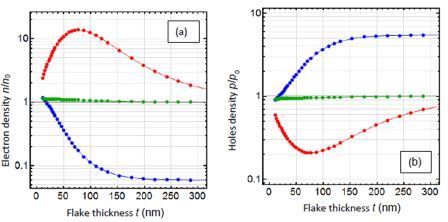Speaker
Description
Bulk TMDs are typically non-polar centrosymmetric semiconductors with a relatively wide band gap ~(1.1 – 2) eV [1], however, on transition from the bulk form to the nanoscale additional orderings emerge [2, 3]. The properties of low-dimensional (LD) transition metal dichalcogenides (TMDs) with a chemical formula MX2 (M – metal Mo, W, Re; X – chalcogen S, Se, Te) and Janus-compounds (JC) with a chemical formula MXY (X, Y – chalcogens) can be changing in a broad range of properties varying from non-polar to ferroelectric, and from direct-band semiconductor to metallic [4, 5]. These opportunities of tunability of polar and semiconducting properties are provided by controlling factors, such as composition, doping, and field effect. However, known studies in this fields are mostly empirical and almost not systematized.
Recently [6] we developed LGD-type theory for the description of polar phenomena in LD-TMDs, specifically explored flexoelectric origin of the polarization induced by a spontaneous bending and by inversion symmetry breaking due to the interactions with substrate. This work is devoted to the establishment of correlation between polar and electronic properties of LD-TMDs and JCs [7]. Using finite element modeling (FEM) we calculated the elastic and electric fields, flexoelectric polarization and free charge density for a TMD (or JC) nanoflake placed on a rough gold substrate with a sinusoidal profile of the corrugation.
Analysis of FEM results obtained for the different flake thickness (varying from 10 layers to 300 nm) and corrugation depth (varying from 0 to 50 nm), allows to corroborate the flexoelectric nature of the out-of-plane electric polarization and establish the unambiguous correlation between the polarization and static conductivity modulation caused by inhomogeneous elastic strains coupled with deformation potential and strain gradients, which evolve in the nanoflake due to the adhesion between the flake surface and corrugated substrate.
We revealed a pronounced maximum at the thickness dependences of the electron and hole conductivity of MoX2 and MXY nanoflakes placed on a substrate with a sinusoidal corrugation. Namely the conductivity is maximal for a (75 - 80) nm thick flakes placed on a gold substrate with the 4 nm corrugation height (see Fig. 1). This result opens the way for the nanoflakes geometry optimization towards significant improvement their polar and electronic properties, which necessary for their advanced applications in nanoelectronics and memory devices.
The work has received funding from the National Research Foundation of Ukraine (Grant application 2020.02/0027, Contrast N 52/02.2020).

FIGURE 1. Thickness dependence of the bending-induced relative static electron (a), and holes (b)
conductivity at the top surface of a MoTe2 placed on a corrugated gold (Au) substrate. Nanoflake top
and bottom surfaces reaction when it is placed at the “top” of the corrugation are shown by red and
blue symbols, respectively; and the nanoflake top reaction when it is placed the at the corrugation
“slope” is shown by green curves. From [7].
[1] S. Kang, S. Kim, S. Jeon, W.-S. Jang, D. Seol, Y.-M. Kim, J. Lee, H. Yang, and Y. Kim.
Atomic-scale symmetry breaking for out-of-plane piezoelectricity in two-dimensional transition
metal dichalcogenides. Nano Energy 58, 57-62 (2019).
[2] S. Yuan, X. Luo, H.L. Chan, C. Xiao, Y. Dai, M. Xie, and J. Hao. Room-temperature
ferroelectricity in MoTe2 down to the atomic monolayer limit. Nat. Commun. 10, 1775 (2019).
[3] K.-A.N. Duerloo, Y. Li, and E.J. Reed, Structural phase transitions in two-dimensional Mo- and
W-dichalcogenide monolayers, Nat. Commun. 5, 4214 (2014).
[4] D.W. Boukhvalov and M.I. Katsnelson. Enhancement of chemical activity in corrugated
graphene. J. Phys. Chem. C 113, 14176 (2009).
[5] S.V. Kalinin, and V. Meunier. Electronic flexoelectricity in low-dimensional systems. Phys.
Rev. B, 77, 033403 (2008).
[6] A.N. Morozovska, E.A. Eliseev, G.I. Dovbeshko, M.D. Glinchuk, Y. Kim, and S.V. Kalinin.
Flexo-induced ferroelectricity in low dimensional transition metal dichalcogenides. Phys. Rev. B
102, 075417 (2020).
[7] A. N. Morozovska, E. A. Eliseev, H. V. Shevliakova, G. I. Dovbeshko, M. D. Glinchuk, Y. Kim,
and S. V. Kalinin. Correlation between corrugation-induced flexoelectric polarization and
conductivity of low-dimensional transition metal dichalcogenides (http://arxiv.org/abs/2011.09326)
